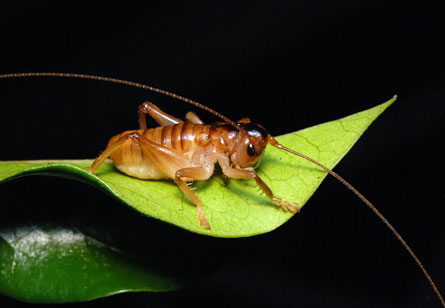Surprise Visitor
Newly discovered cricket pollinates orchids in nighttime rendezvous
Réunion is an island of surprises. It is French, but it’s nowhere near France — it’s off the east coast of southern Africa. After dark on this island, scientists use night-vision cameras to spy on the flowers. They want to learn more about pollination, which is how many plants reproduce. A plant becomes pollinated when pollen, which looks like powder, is moved from the male to the female part of the plant.
And now for the strange part: While watching an orchid at night, these researchers recently filmed a new kind of cricket — one never before reported by scientists. Not only was the cricket new, but it was doing something never observed in any kind of cricket: It was pollinating the orchid. The scientists, who are from France and England, reported on the new cricket — and its new behavior — in a recent paper.
 |
|
View video | This cricket species is the first insect of its kind known to pollinate flowers.
|
| Sylvain Hugel |
Claire Micheneau, who worked on the study, is finishing her Ph.D. at a university on Réunion. (A Ph.D., also known as a doctorate, is an advanced academic degree. University professors in the sciences usually have earned a Ph.D.) “This was very unexpected,” says Micheneau, who worked with scientists from the Royal Botanic Gardens, Kew in England. “The answer to a question brings us further questions.” Scientists would like to know, for example if cricket pollination is more common than they thought.
Micheneau and her colleagues weren’t looking for crickets. They wanted to know how an orchid called Angraecum cadetii becomes pollinated, so they aimed their night-vision cameras at the flowers and hit the “record” button. For a flower to make seeds that can grow into new plants, the flower needs to be pollinated: Pollen from the male part of a flower has to land on the female part of the flower, the stigma. Wind might help the pollen get there—or bugs like bees and butterflies, or birds, might. Surprisingly, in recent years scientists have even seen lizards and cockroaches carrying pollen from flower to flower. But never have they seen crickets doing so — until now.
When the scientists watched the movies they recorded, they saw a cricket moving away from an orchid with pollen on its head. They considered that maybe this was one strange cricket, so they set up the experiment again and recorded that type of orchid for many hours. Over and over, they saw the same thing: Crickets were pollinating the flowers.
W. Scott Armbruster, a scientist at the University of Alaska in Fairbanks, says if flowers are growing far from where they originated, they might attract strange pollinators — like crickets or lizards. (Armbruster did not work on the orchid study.) This orchid, for example, probably originated on the nearby island of Madagascar but at some point migrated across the water.
The orchid and this type of cricket seem made for each other. The orchid gives off its sweet smell at night, when the crickets are out — and can snack on the orchid’s delicious nectar. This cricket is particularly good at finding its way around every night, so it could easily find the orchids in the dark and remember where to find them later. “It was the right orchid and the right cricket,” Armbruster told Science News.
Armbruster notes that the word biodiversity usually refers to a list of all the different kinds, or species, of organisms that exist in a place — so the biodiversity of Réunion would include both the orchids and the crickets. He says that should change: “We tend to think of biodiversity in terms of lists of species, but it is actually lists of interactions”—meaning the relationships between different species like the orchid and the cricket.
The French word reunion means “meeting” — which seems fitting for this pair. The meeting of the cricket and the orchid may be a surprise, but it’s no surprise to scientists that different species are so strongly connected and depend on each other for survival.
POWER WORDS (adapted from the Yahoo! Kids Dictionary)
pollinate To transfer pollen from an anther to the stigma of a flower.
orchids The largest family of flowering plants, found chiefly in the tropics and subtropics and characterized by showy flowers, strong relationships with pollinators and dustlike seeds.
biodiversity The number and variety of organisms found within a geographic region; also, arguably, the number of interactions among organisms.
species A fundamental group of organisms capable of interbreeding.
anther The pollen-bearing part of the stamen (the organ that produces the pollen).
stigma The receptive portion of a flower where pollen is deposited at pollination.
pollen The fine, powderlike material consisting of pollen grains, which is produced by the anthers of seed plants.
Cricket Takes Plunge? from Science News on Vimeo.
A new species of raspy cricket is caught on film pollinating the Réunion island orchid Angraecum cadetii. It is the first documented instance of flower pollination by a cricket.
Video credit: Claire Michenau and Jacques Fournel
Going Deeper:







